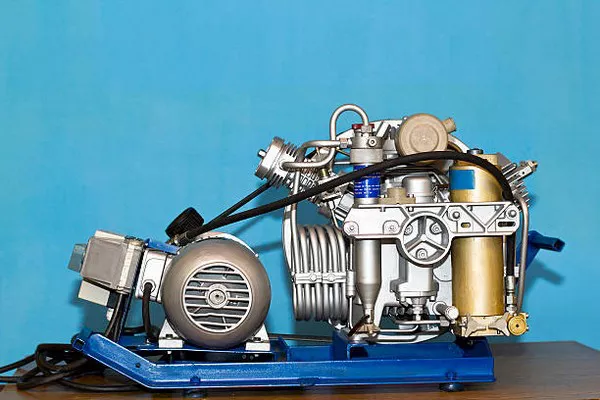Air compressors are essential tools in various industries, from automotive repair shops to manufacturing facilities, where compressed air is required for powering tools and machinery. When choosing an air compressor, one of the primary decisions you’ll face is whether to opt for a direct drive or belt drive model. Both types have their advantages and disadvantages, and the choice depends on your specific needs and preferences. In this article, we will explore the differences between direct drive and belt drive air compressors to help you make an informed decision.
Direct Drive Air Compressors
Direct drive air compressors, also known as “direct drive compressors” or “fixed drive compressors,” have a motor directly connected to the compressor pump. This configuration eliminates the need for belts and pulleys, resulting in a more compact and straightforward design. Direct drive compressors are known for their efficiency and low maintenance requirements, making them a popular choice for many applications.
Advantages of Direct Drive Air Compressors
Compact Design: Direct drive compressors are typically more compact and lightweight than their belt drive counterparts. This makes them suitable for small workshops or mobile applications where space is limited.
Efficiency: Direct drive compressors are more efficient because they have fewer moving parts, reducing energy losses. This translates into lower energy consumption and operating costs over time.
Low Maintenance: With fewer components, direct drive compressors require less maintenance. There are no belts to replace or tension, which means less downtime and reduced maintenance costs.
Cost-Effective: Initially, direct drive compressors are often more affordable than belt drive models, making them an attractive option for budget-conscious consumers.
Easy Start-Up: Direct drive compressors typically have a quick and easy start-up process, which is ideal for applications where intermittent use is common.
Disadvantages of Direct Drive Air Compressors
Noise and Heat: Direct drive compressors can be noisier and generate more heat due to the direct connection between the motor and pump. This may not be suitable for noise-sensitive environments or prolonged use.
Limited Power Range: Direct drive compressors are generally available in lower horsepower ranges compared to belt drive compressors. This limitation can affect their suitability for heavy-duty industrial applications.
Belt Drive Air Compressors
Belt drive air compressors, also referred to as “belt-driven compressors” or “industrial compressors,” feature a motor connected to the compressor pump via a belt and pulley system. This setup allows for greater flexibility in terms of power output and provides several advantages, particularly for industrial and heavy-duty applications.
Advantages of Belt Drive Air Compressors
Power Range: Belt drive compressors offer a broader range of power options, from small units suitable for light tasks to large, high-powered models capable of handling heavy-duty industrial workloads. This flexibility makes them more versatile.
Reduced Noise and Heat: The belt and pulley system in belt drive compressors helps reduce noise and heat generation, making them a better choice for quieter work environments and extended use.
Better Cooling: The belt-driven configuration often includes a flywheel that provides better cooling for the compressor pump. This can result in longer pump life and improved performance.
Durability: Belt drive compressors tend to have a longer lifespan compared to direct drive models, thanks to their robust construction and the ability to handle higher loads.
Customization: Users can customize the power output of belt drive compressors by changing the pulley size or adjusting the belt tension, allowing for fine-tuning to specific requirements.
Disadvantages of Belt Drive Air Compressors
Maintenance: Belt drive compressors require more maintenance than their direct drive counterparts. Belts may need periodic replacement, and proper tensioning is essential to ensure optimal performance.
Larger Footprint: Due to the belt and pulley system, belt drive compressors tend to be bulkier and heavier, which can be a drawback in smaller workshops or when mobility is a priority.
Higher Initial Cost: Belt drive compressors are generally more expensive upfront than direct drive models, making them less attractive to those on a tight budget.
Choosing the Right Air Compressor for Your Needs
The decision between a direct drive and belt drive air compressor ultimately depends on your specific requirements and preferences. Here are some factors to consider when making your choice:
Workload: Consider the type and frequency of tasks you’ll be using the compressor for. If you need a compressor for light-duty or intermittent use, a direct drive model may suffice. However, for continuous or heavy-duty applications, a belt drive compressor is a better choice.
Space: Evaluate the available space in your workshop or workspace. Direct drive compressors are more space-efficient, while belt drive compressors require more room due to their larger footprint.
Noise: If noise levels are a concern, especially in residential or quiet work environments, a belt drive compressor is typically quieter than a direct drive unit.
Budget: Determine your budget and weigh the initial cost against long-term operating and maintenance costs. While direct drive compressors are more budget-friendly upfront, belt drive models may provide better durability and value over time.
Customization: If you require specific power output options, a belt drive compressor’s adjustability can be advantageous.
Mobility: If you need a portable compressor for on-site work or mobile applications, the compact design of a direct drive compressor may be more convenient.
Conclusion
In the direct drive vs. belt drive air compressor debate, there is no one-size-fits-all answer. Both types have their unique advantages and disadvantages, and the best choice depends on your individual needs and priorities. To make an informed decision, carefully assess factors such as workload, available space, noise considerations, budget, customization requirements, and mobility. By doing so, you can select the air compressor that will best serve your specific application, whether it’s for light-duty tasks in a small workshop or heavy-duty industrial operations.

